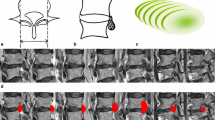Summary
A retrospective analysis of 45 patients with intra- and extracanalicular lumbar disc herniations (ICDH, ECDH), collected over a 3 year period, is presented. When an intra- or extracanalicular DH was suspected, 1.5 mm axial cuts were made with a GE 9800 from the cranial pedicle through the intervertebral canal to the pedicle of the lower vertebral body. Constructions were then made in coronal and paraxial planes to identify the pathology and its relation to the nerve root. 47% of all ICDH and ECDH were found at the level L4/5, 24% each at the levels L3/4 and L5/S1 respectively and 4% at the level L2/3. In 78% of our patients, the disc fragment was extruded and found well above the level of the disc space, in 22% at the level of the disc space. The coronal reformated views were in general better for demonstrating the course of the compressed nerve root at the levels L2/3–L4/5, while at L5/S1 the paraxial reformated view may yield better images. The distance from the midline of the spinal canal to the medial and lateral edge of the ECDH averages 16.4±3.4 and 33.3±3.6 mm and in some cases the lateral edge was found 39–44 mm from the midline. Pitfalls in the diagnosis of ECDH may be caused by scar tissue, sometimes by an upwardly displaced nerve root or ganglion and, very rarely, by a neurinoma. Pitfalls in therapy, i.g. false negative intraspinal exploration in cases of intraor extracanalicular disc herniations or exploration of the wrong intervertebral canal, may result due to insufficient neuroradiological analysis or from insufficient consideration of the anatomical situation by the neurosurgeon.
Similar content being viewed by others
References
Abdullah AAF, Ditto EW, Byrd EB, Williams R (1974) Extreme-lateral lumbal disc herniations: clinical syndrome and special problems of diagnosis. J Neurosurg 41: 229–234
Ebeling U, Reulen H-J (1983) Der lateral lumbale Bandschei-benvorfall. Der Nervenarzt 54: 521–524
Ebeling U, Reulen H-J, Stoeter P (1983) Zur Diagnostik und Therapie lateraler Bandscheibenvorfälle II. Einteilung, Pathomechanismus und Entstehung, radiologischer Nachweis und chirurgische Zugangswege. Neurochirurgie 26: 80–85
Epstein NE, Epstein JA, Carras R, Hyman RA, Murthy Vishnubakhat S (1986) Far lateral lumbar disc herniation: Diagnosis and surgical management. Neuro-Orthopedics 1: 37–44
Kurobane Y, Takahashi T, Tajima Tet al (1986) Extraforaminal disc herniation. Spine 11: 260–268
Novetsky GJ, Berlin J, Epstein JA, Miller SH (1982) The extraforaminal herniated disc. Detection by computed tomography. AJNR 3: 653–655
Patrick BY (1975) Extreme lateral ruptures of lumbar intervertebral discs. Surg Neurol 3: 301–304
Pfaundler S, Ebeling U, Reulen H-J (1989) Pedicle Origin and Intervertebral Compartment in the Lumbar and Upper Sacral Spine. Acta Neurochir (Wien) 97: 158–165
Reulen H-J, Pfaundler S, Ebeling U (1987) The lateral microsurgical approach to the “extracanalicular” lumbar disc herniation. Acta Neurochir (Wien) 84: 64–67
Williams AL, Haughton DL, Thornton RS (1982) CT recognition of lateral lumbar disc herniation. AJNR 3: 211–213
Author information
Authors and Affiliations
Rights and permissions
About this article
Cite this article
Huber, P., Reulen, H.J. CT-observations of the intra- and extracanalicular disc herniation. Acta neurochir 100, 3–11 (1989). https://doi.org/10.1007/BF01405267
Issue Date:
DOI: https://doi.org/10.1007/BF01405267




